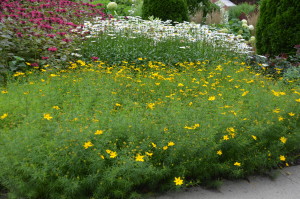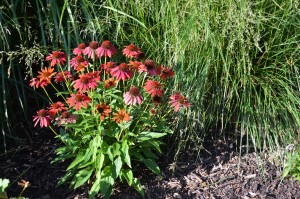In late winter – early spring, after the snow has melted and daytime temperatures are steadily above freezing, let’s get busy with the cleanup in the perennial garden. First, if you garden in a severe winter region such as zones 4 or colder, remove all winter protection such as evergreen boughs or protective mulches. Many perennials need sunlight as they peak through the ground.
All leaf and twig debris, dead flowers, stems and seed heads should be pruned off. Perennials, such as tickseed (Coreopsis), shasta daisy, garden phlox, asters, and coneflowers (Echinacea), form green rosettes; new flowering shoots will sprout up as sun and warm temperatures reach them.
Weeding garden beds should be your next chore. It may be difficult not to confuse weeds from newly emerging perennials. Follow-up with fertilizing and mulching garden beds. Organic-based slow release fertilizers are preferred as nutrients are metered out over the growing season. Avoid fertilizing plants if the foliage is wet so as not to burn the tender spring growth.
Apply 2-3 inches of pine bark or pine straw mulch near plant but don’t pile mulch around the plant base. Using compost as mulch supplies nutrition for early spring wildflowers such as bloodroot, primula, Virginia bluebells, trilliums and many others.
If needed, divide or transplant newly emerging perennials in the early spring. It’s best to divide most perennials when they are about 2 to 4 inches tall. Never move or divide perennials when they’re flowering. A certain number of perennials are best divided after they bloom. That list includes hostas, oriental poppies (Papaver), Siberian iris, bearded iris, lilies (Lilium) and daylilies (Hemerocallis). Peonies are best divided in the fall.
You may need to stake tall growing perennials using cages or hoops for peonies, Joe Pyes (Eupatorium spp), and baptisias (false indigo). Remove spent flowers from tulips, daffodils, and other spring-flowering bulbs, but let the foliage to die down naturally. Think of bulb leaves as solar collectors to replenish food energy in the bulb for next spring. Do not braid the leaves.



 Posted in
Posted in 
